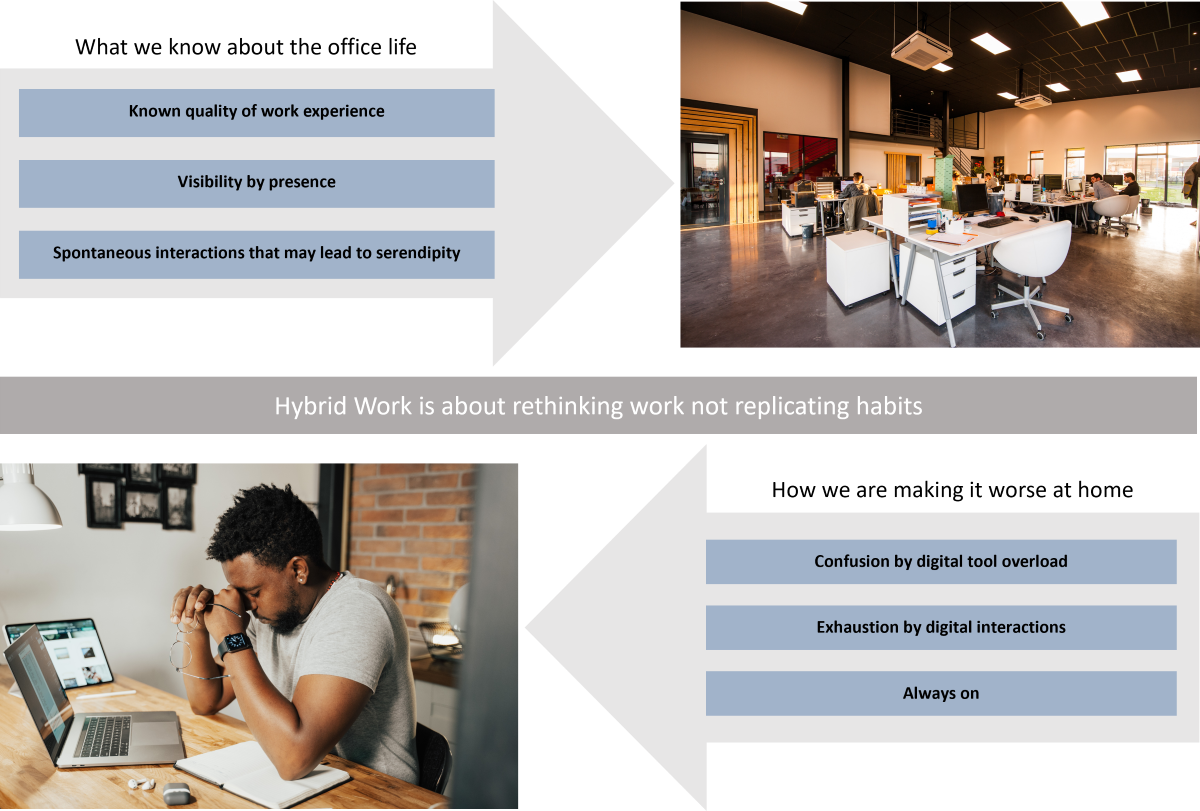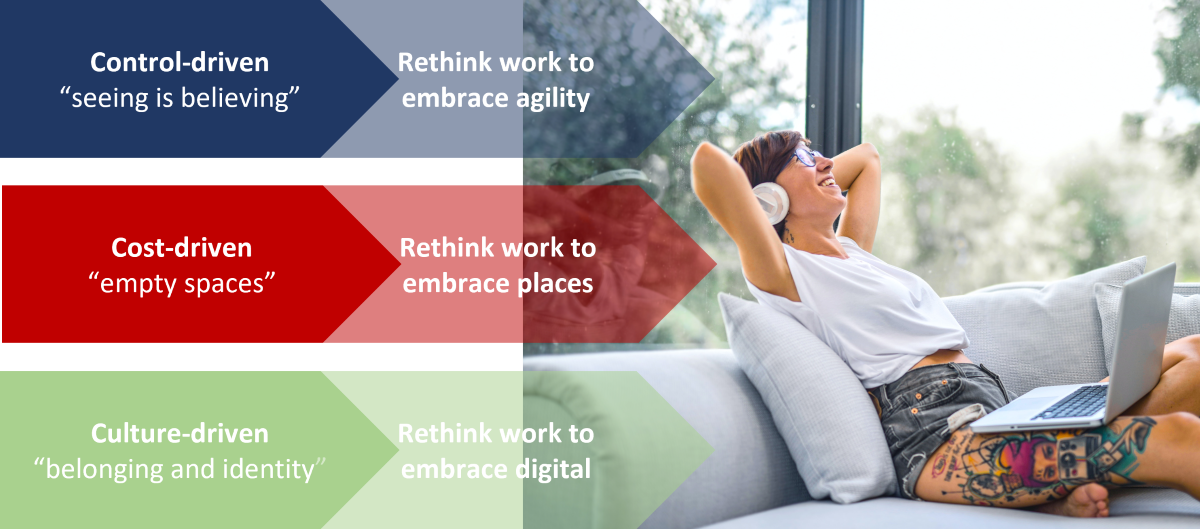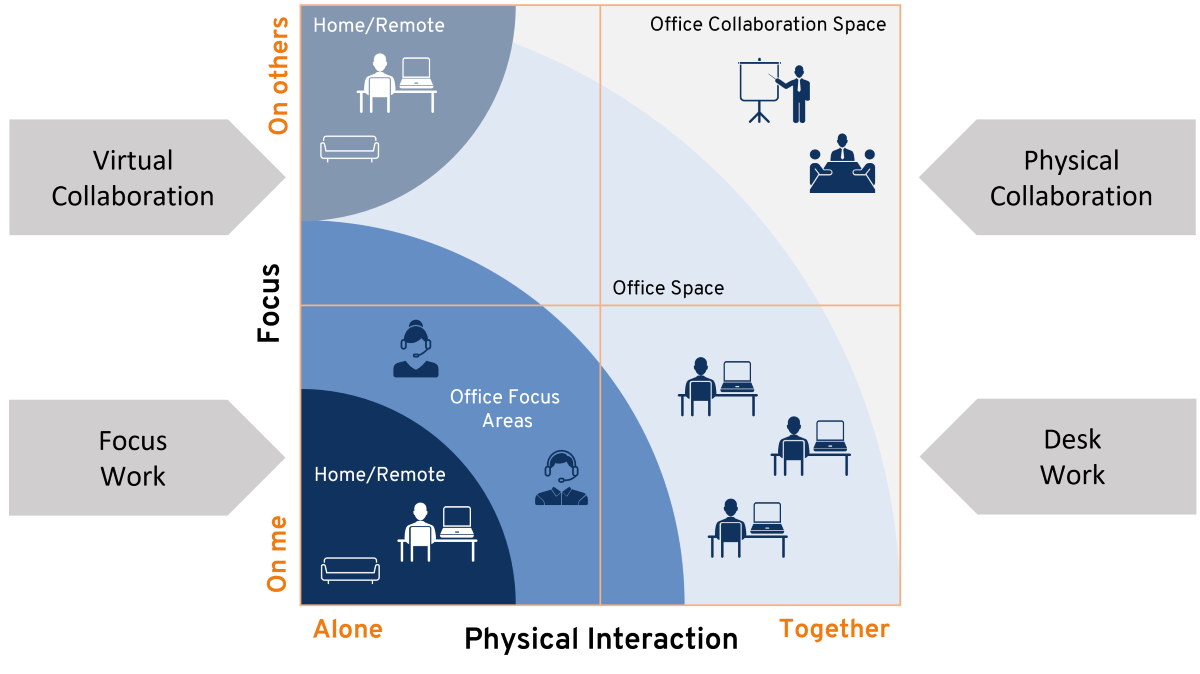Covid has taught us that the digital workplace is not about the place of work – but about the state of working. We have seen that it is often corporate culture, not technology, that is the constraining factor.
The journey of the last few months has led to three insights:
- The digital workplace is more a state rather than a result. It is a business and IT obligation to manage this state as part of a new digital self-image.
- The digital workplace is always about people and technology, apps/services and devices. It's not an either - or.
If you provide devices or services that result in a bad experience at the point of use, you reinforce avoidance and disengagement.
Today, a glimpse of old-normal appears on the horizon to challenge the new-normal.
Companies are thinking about letting their people return to the office, and we're finding that the reasons for returning to the office often come across as disguised.
When we ask our clients about their reasons for employees returning to the office, we typically hear three types of arguments:
- Control-driven - Belief set “seeing is believing”
- Cost-driven - Belief set “empty spaces”
- Culture-driven - Belief set “belonging and identity”
There is no doubt that a well-designed office environment can contribute to the well-being and health of employees, foster identity and belonging, and also provide space for creativity and innovation.
From the employee's perspective, the question often arises as to why they need to commute to attend the same virtual meeting they have been attending from home for the past few months.
Up to 40% of employees intend to leave if they are forced back to the office
Various surveys have been conducted, from McKinsey to Gartner, from Microsoft to Bloomberg, and all conclude that up to 40% of employees intend to leave the company when companies “revert” to the office. Companies that make this a power play and force their employees into the office should be aware of this.
To understand this number, we need to see that employees as a group have become more complex, since we have now three different groups with different requirements:
- People onboarded before Covid-pandemic
- How do we maintain connection and togetherness?
- People onboarded during Covid-pandemic
- How do we establish connection and togetherness?
- People onboarded after Covid-pandemic.
- How do we embrace hybrid?
The preference for working remotely and the corresponding opportunities offered by companies are becoming a competitive advantage in the battle for talent and also an important instrument for employee retention.
The good news, however, is that according to our observations, the majority of business leaders confirm that hybrid work is meant to stay. The question now is how to design hybrid work to leverage the benefits while avoiding pitfalls and adopting the lessons of the pandemic.
Many discussions go in the direction of rethinking (digital) work, but rethinking digital work is a complex undertaking and depends on a digital culture that embraces employee-centricity, leadership, psychological safety, self-organizing teams, agility, and so on.
For this reason, it may be appropriate to think of back-to-office programs as a step toward rethinking digital work, rather than the result of rethinking digital work.
Let's take the agile route and consider back-to-offce an initial Minimum Viable Product, or better yet, a Minimum Lovable Product that acknowledges that Remote Work has become a hygiene factor.
Understand the office as social anchor where people and culture meet
When we talk about hybrid work, we need to remember that distributed work is not a new phenomenon. However, the excessiveness with which distributed work became necessary in a very short time is extraordinary (or legendary). A key finding from distributed work research is that people need interpersonal touch points to stay connected and maintain identification with the organization, i.e. managing the organization's social capital.
To care about distributed work is to design for human moments, and to shape digital work after the Covid pandemic, we therefore advise first understanding employees as key stakeholders. With employees at the center, organizations become an employee-centric company and can thereby become a successful customer-centric company.
By putting your people at the center and rethinking office from there, you can also begin to understand and recognize the corporate office as a social anchor where people and your corporate culture meet to create a new level of togetherness.
There are many good reasons why back to the office makes sense, and it's important to recognize that it's about much more than just the place of work. For us, therefore, a good starting point for a user-centric back-to-office program would be an answer to the question of “why back to office” that is neither cost-driven nor control-driven.
To avoid a "back to the office" in the sense of returning to pre-pandemic procedures, it is necessary to develop a solid understanding of employees' experiences before and during the pandemic, as well as how they evaluate their employer's performance in caring for their people.
It is employee experience at the intersection of workplace activity, work mode, technology, place, and environment what we can call the digital work state experience. Caring for that experience will be a starting point to rethink digital work and digital workplaces.
A good step to progress in transforming your digital work experience is to review your personas to align with the lessons learned from the pandemic. If you haven't already, the next step is establishing activity-based work initiatives to connect your personas to the work mode and location of the workplace activity to create the best possible workplace experience.
Transforming the digital workplace into a digital work state experience also means shaping structural leadership and transforming digital work into an adaptive and inspiring digital momentum of learning, innovation, and growth.
As AdEx Partners, we make your transformation successful because we care about people. Team up with us and put your people first to create a digital work state experience that sustainably connects talent and technology.
Contact
Contact AdEx Partners, your Trusted Advisor via www.adexpartners.com or follow us on LinkedIn and Twitter.




